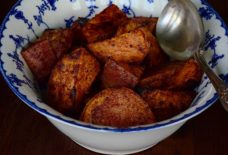Popular in the Arab World? Lemon Blueberry Biscuit Cake
By: Blanche Shaheen/ Arab America Contributing Writer
While a typical vanilla biscuit may seem plain and rather humble, in reality these cookies have had an illustrious and globetrotting past. The word biscuit is derived from the Latin words “bis cotus”, meaning twice baked, hence their initial popularity among the Romans. However, the creation of the biscuits we are familiar with today truly started during the Industrial Revolution, when the mass production of cakes and biscuits began.
The Digestive biscuit was invented in 1892 by Alexander Grant in England. Around the same time, the Marie biscuit was created by a London bakery in 1874 to commemorate the marriage of the Grand Duchess Maria Alexandrovna of Russia to the Duke of Edinburgh. Shortly after, the transformation of these biscuits into decadent biscuit cakes began. The popularity of both the biscuits and biscuit cakes spread to Ireland, Denmark, Spain, and Portugal, then hopped over to Arab countries in the Levant. To this day it is not unusual to see a Palestinian or Lebanese grandmother enjoying these biscuits with afternoon tea, with an extra biscuit cake wrapped in foil in the freezer in case guests come over.
What exactly is a biscuit cake?
A biscuit cake is a type of no bake tea cake, where digestive or Marie biscuits replace the actual cake layers. The biscuits are either crumbled or layered, held together with a batter containing either condensed milk, pudding, or custard, then molded into a terrine or loaf pan. Many Arab home cooks also like to mold the cake into a cylinder and wrap in foil, so that it can be cut into slices. Some add optional dry ingredients to the batter like candied cherries, walnuts, pistachios, almonds, sultanas, or dried apricots. The cake has to set in the refrigerator for at least 2 hours before serving. The closest equivalent to this cake in America is the icebox cake.
While most biscuit cakes are made with chocolate, the following recipe uses an unlikely ingredient for the batter– Labneh cheese, or Arabic style kefir cheese. As Labneh is smooth, creamy and slightly tart, it pairs well with fruit purees and jams. In this case lemon curd provides a sweet and citrusy counterpoint to the labneh, along with fresh blueberries and crunchy pistachios. This cake is refreshing for summertime, especially when garnished with fresh berries, and can be frozen until ready to eat.
To see the easy technique of how to make this cake, click on the video below:
Lemon Blueberry Biscuit Cake
1 cup Labneh cheese
½ cup lemon curd
¼ cup sweetened condensed milk
1 package rectangular petite beurre or Marie biscuits
Optional Garnishes
Whipped Cream
Chopped Pistachio Nuts
Blueberries, Raspberries, or Strawberries
Instructions
Using a hand mixer, blend with labneh cheese and lemon curd until smooth. Add the condensed milk and blend until well incorporated. Put a piece of parchment paper in a bread loaf pan. Start by adding a large spoon of the lemon curd mix to the bottom, then line with 6 of the biscuits. Add another layer of the Labneh batter, and repeat layers until all of the batter is used up. Cover with plastic wrap and refrigerate for at least 2 hours. Once set, carefully flip the cake upside down and remove the parchment paper. Smooth the sides and top with a knife. If you wish you can add a layer of whipped cream on the top. Garnish with pistachios and blueberries, then serve.
Blanche Shaheen is the author of the cookbook called “Feast In the Middle East, a Journey of Family and Cuisine” which you can order here: https://secure.mybookorders.com/mbo_index.php?isbn=9781545675113 She is also a journalist, and host of the popular cooking show called Feast in the Middle East. She specializes in Arab cuisine of the Levant and beyond. You can check out her cooking video tutorials at https://www.youtube.com/user/blanchetv Her recipes can also be found at https://feastinthemiddleeast.wordpress.com/
Check out our blog here!









